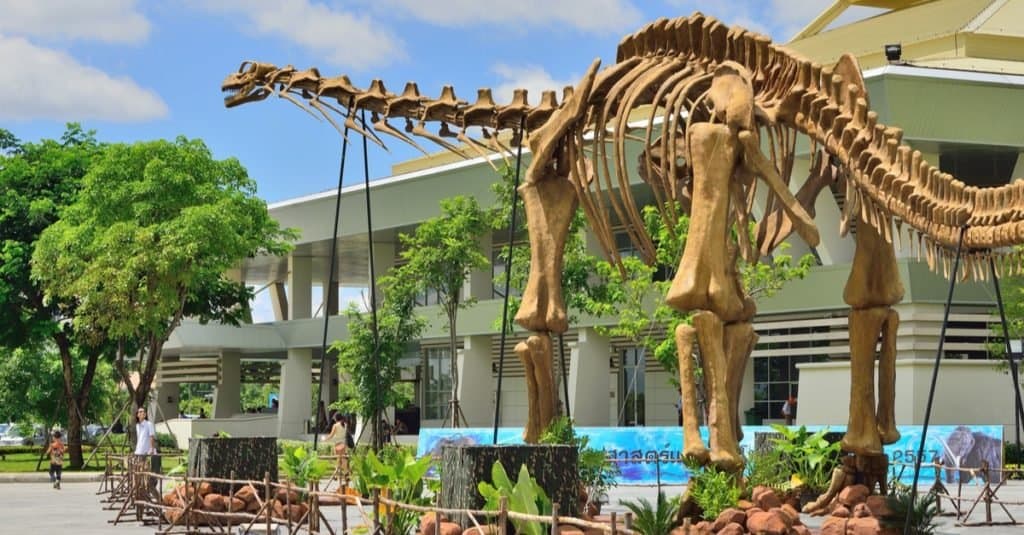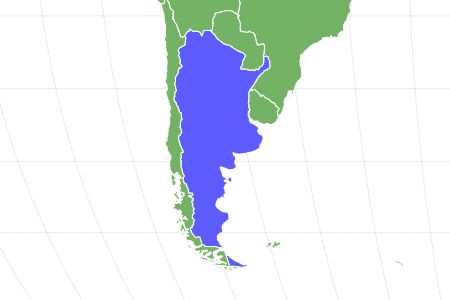Argentinosaurus
The Argentinosaurus weighed as much as 10 elephants!
Advertisement
Argentinosaurus Scientific Classification
Read our Complete Guide to Classification of Animals.
Argentinosaurus Conservation Status
Argentinosaurus Physical Characteristics
View all of the Argentinosaurus images!
Introduction
The Argentinosaurus is a genus of sauropod dinosaurs that lived 92 to 100 million years ago during the Late Cretaceous period. They are considered to be one of the largest herbivorous dinosaurs to walk the earth. Their fossils have been found in Argentina in South America, hence this dinosaur’s name. In 1993, the genus only had one species, the Argentinosaurus huinculensis. This name means the “Argentine lizard”, but now there have been several other species in this to the genus.
Argentinosaurs are a type of dinosaur referred to as Titanosaurs because of their gigantic size and armored sauropods. Given the Argentinosaurs large size, they were relatively slow creatures that had a speed of only five miles per hour. They stayed in herds of other Argentinosaurs like many other large herbivorous animals.
Description & Size

Argentinosaurus huinculensis in front of the hall of the National Science and Technology fair in Chiangmai Province.
©watthanachai/Shutterstock.com
The Argentinosaurus was massive, reaching an adult length of a whopping 98 to 115 feet in length and weighing around 65 to 75 tons. However, they could have been slightly larger or smaller due to the remains being incomplete. It took approximately 15 to 40 years for the Argentinosaurus to reach its full maximum size. The juveniles likely reached maturity slower than warm-blooded dinosaurs.
The Argentinosaurs legs were around 15 feet long, and their hip-to-shoulder length was around 23 feet with an overall body length of 98 feet according to Kenneth Carpenter who reconstructed the Argentinosaurus in 2006. There have been more reconstructions of the Argentinosaurus throughout the years. They are all rough estimates as to how large the Argentinosaurus could have been.
Since the Argentinosaurus is thought to be a type of basal titanosaur. They were likely to have a short tail and a narrow chest. Their most distinctive feature being their extremely long necks and small heads. The Argentinosaurus had thick, tree trunk-like legs with rounded feet that helped distribute the heavy weight of this dinosaur. They also had a long and narrow tail and thick neck.
The Argentinosaurus is believed to have been a grey color with thick and tough skin. They could have had a pattern along their spine leading to their tails. It is unclear how the Argentinosaurus held its neck. It is possible they could move it to eat from tall trees or bend it downwards to drink water. They seemed to be similar to how a giraffe would move its neck. The only issue is that if the Argentinosaurus had to hold its neck high up into the air, it would put immense stress on its heart. It would have to pump blood throughout the body when the neck is 40 feet up into the air.
Diet – What Did The Argentinosaurus Eat?
The Argentinosaurus was an herbivore that ate a mixture of different foliage from plants like trees and bushes. Their long necks allowed them to eat the leaves from the tops of tall trees. It could also have helped them maneuver their heads to eat the leaves from in-between large branches.
This dinosaur primarily ate plant and tree materials that made them a large plant-eating dinosaur. Given their large size, they would have needed to consume 1,220 to 1,269 pounds of foliage a day to sustain their total body mass, which is a lot of food! This would mean that a large herd of Argentinosaurs could easily consume a huge amount of trees in a day. This would lead to a lot of tree and plant damage in the areas where they would eat the leaves from.
Since the Argentinosaurus lived during the Late Cretaceous period, the types of fauna that grew at the time could be an indication as to what types of plants these big dinosaurs ate. A range of flowering plants also grew in temperate regions, such as rose bushes. The fossil pollen inside the Argentinosaur fossil indicates they ate a variety of flowering plants. Some of the plants included liverworts, ferns, hornworts, gymnosperms, angiosperms, conifer, and selaginellales plants.
Habitat – When and Where It lived
The Argentinosaurus lived during the Late Cretaceous period 92 to 100 million years ago in Argentina, South America. This is where the first fossil bones were discovered. This dinosaur’s large size would make it difficult for them to inhabit forests. They would knock down trees and cause destruction with every step they took.
Instead, the Argentinosaurus probably lived in open areas where there were plenty of trees spread out. Here the Argentinosaurus lived in herds and laid their large eggs in nests that they made in the ground.
Threats And Predators
The Argentinosaurus’ large size didn’t make them an easy predator, even though they were not able to defend themselves well. One dinosaur that preyed on the Argentinosaurus was likely the Mapusaurus, which is one of the largest known theropods.
The Mapusaurus hunted in packs to bring down a single adult Argentinosaurus. Larger carnivorous dinosaurs would have also posed a threat to the Argentinosaurus. The giganotosaurus was a large theropod dinosaur that also lived in Argentina during the same period as the Argentinosaurus. Since the Argentinosaurus took years to develop into a large adult, it is possible that young juveniles or hatchling Argentinosaurs were easier to hunt than adults.
Discoveries and Fossils
The first Argentinosaurus was discovered in 1987 by a rancher named Guillermo Heredia near the city of Plaza Huincul in Argentina who had first mistaken the bones for a piece of petrified wood. A single bone was only discovered, and this took the interest of a scientific excavation team led by a paleontologist named Jose Bonaparte in 1989 who found back vertebrae and parts of the dinosaur’s sacrum. After this discovery, a fully completed specimen of the Argentinosaurus has never been found, which is why scientists have a difficult time coming to a definite conclusion as to how big the Argentinosaurus truly was.
Jose Bonaparte along with other members of the Museo Argentino de Ciencias Naturales yielded the bones of the individual dinosaur which later become a holotype named the A. huinculensis. The bones found were as large as a human.
These bones found in hard rock, which meant that the team had to use pneumatic hammers to collect them. The Argentinosaurs’ sacral vertebrae, sacral ribs, and dorsal ribs are in a collection of the Museo Carmen Funes. Jose then showed his new findings at a scientific conference in San Juan which then led to an Argentine paleontologist Rodolfo Coria naming the genus and species.
Extinction – When Did It Die Out?
The Argentinosaurus died 92 to 100 million years ago when the Late Cretaceous period ended. The reason for the Argentinosaurs extinction is unknown, but it is possible that they went extinct due to the KT mass extinction. This extinction killed off a large percentage of plant and animal species at the time due to an asteroid that left a crater in the earth’s atmosphere resulting in dust and debris that blocked the earth’s sun, which lowered the overall temperature. The Argentinosaurus who ate an herbivorous diet might have not had any plants left to eat because the plants were unable to photosynthesize properly and grow due to not receiving sunlight.
Similar Animals to The Argentinosaurus
There are several large species of titanosaur that closely resemble the Argentinosaurus.
- Puertasaurus- A genus of South American sauropod with a long neck and found in South America during the Late Cretaceous period.
- Paralititan- A gigantic titanosaurian genus of dinosaurs that inhabited Africa.
- Dreadnaughts- A genus of sauropod dinosaurs that contains a single species.
- Alamosaurus- A genus of sauropod dinosaurs that lived in southern North America and reaches a comparable size of 98 feet just like the Argentinosaurus.
Argentinosaurus FAQs (Frequently Asked Questions)
When was the Argentinosaurus alive?
The Argentinosaurus lived 92 to 100 million years ago during the Late Cretaceous period in a place we now know as Argentina in South America.
How big was the Argentinosaurus?
The exact size of the Argentinosaurus is unknow to scientists because of the lack of a complete skeleton. However, the Argentinosaurus is estimated to be around 98 to 115 feet in size and weighs up to 75 tons.
Thank you for reading! Have some feedback for us? Contact the AZ Animals editorial team.
Sources
- Wikipedia , Available here: https://en.wikipedia.org/wiki/Argentinosaurus
- New dinosaurs , Available here: https://www.newdinosaurs.com/argentinosaurus/
- Dinosaur enclyclopedia , Available here: https://dinosaurencyclopedia.org/argentinosaurus/

















